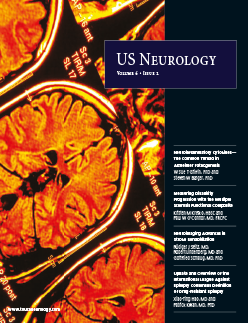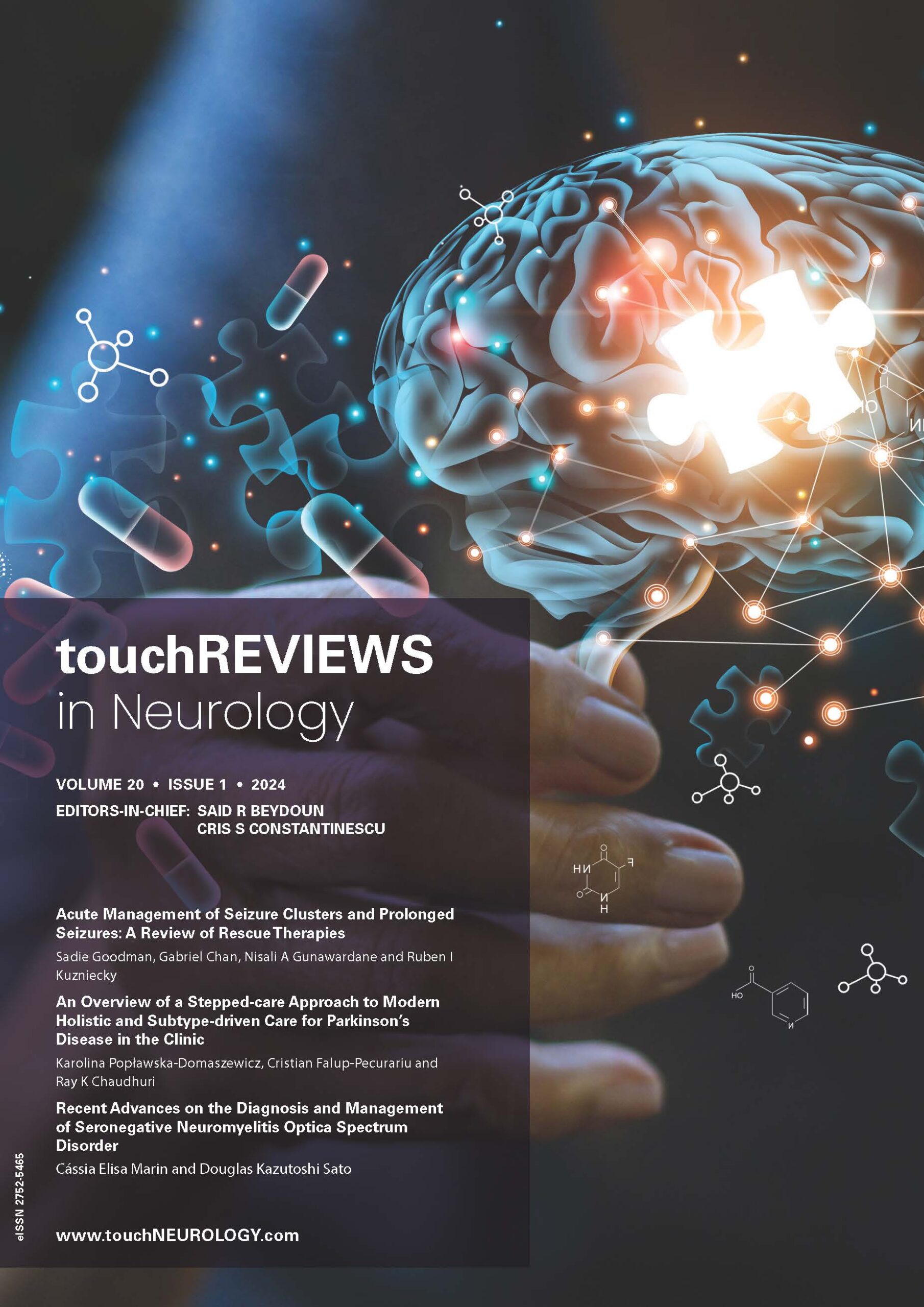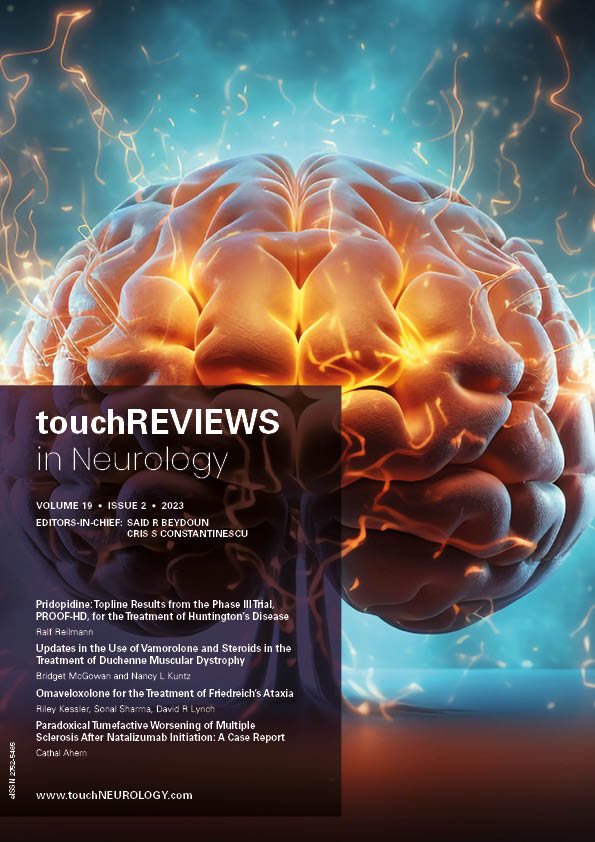
US NEUROLOGY – VOLUME 6 ISSUE 2 – FALL 2010
Foreword
Neurology has moved from being an elitist specialty to a broad specialty based in emergency medicine as well as in public health. This edition of US Neurology includes important information about stroke and dementia in addition to several central issues in neurology.
Current Issues
Infections have been and will likely always remain a significant concern for surgeons throughout the world. Surgical site infections (SSI) are a considerable burden for both patients and healthcare systems alike, often resulting in patient morbidity and mortality as well as significant costs to the healthcare organization. Healthcare costs associated with SSIs have been estimated […]
Neurodegenerative Disease
Alzheimer’s disease (AD) is the epitome of a progressive degenerative disease of the brain and culminates in dementia characterized in the beginning stages as a failure to retain new information for appropriate retrieval. As the underlying disease progresses, the patient experiences more profound memory loss and retrieval dysfunctions. These include not only the loss of […]
Neurodegenerative dementia has become the most rapidly growing cause of severe disability in the world. The most important risk factor is old age, while genetics and lifestyle also contribute. Therefore, better treatment and effective intervention are urgently needed at an early stage before the onset of severe disability. This requires further research into the risk […]
Alzheimer’s disease (AD) is a major source of disability and mortality among older people. AD prevalence is rapidly increasing with increasing lifespan and a larger absolute number of elders. Current treatments, such as cholinesterase inhibitors or N-methyl-D-aspartic acid antagonists are supportive or palliative in nature, and are based on optimizing neurotransmission, but do not alter […]
Oral levodopa remains the most effective symptomatic drug for Parkinson’s disease (PD); however, its long-term use is limited by the emergence of motor fluctuations and involuntary movements, particularly in young-onset patients. A growing number of pre-clinical and clinical studies suggest that non-physiological pulsatile stimulation of striatal dopamine (DA) receptors induced by the use of short-acting […]
Brain Trauma
Psychiatric disorders frequently occur following a traumatic brain injury (TBI) and depression is the most common.1,2 When psychiatric diagnostic criteria are used, the prevalence of major depressive episode (MDE) in persons with moderate to severe TBI ranges from 26–36%.3–7 A recent study in the Journal Of the American Medical Association suggests that the first-year incidence […]
The classic definition of transient ischemic attacks (TIAs) based on focal neurological deficits most likely due to cerebrovascular diseases with full recovery within 24 hours dates back to the 1960s.1 With the advent of advanced neuroimaging techniques (computed tomography [CT] and magnetic resonance imaging [MRI]), new insights into pathobiology and prognosis of cerebrovascular events, as […]
Paraneoplastic neurological syndromes (PNS) were first described in the 20th century. A summary of observations dating back to 1982 was published in the seminal book by Henson and Urich.1 The detection of autoantibodies for myasthenia gravis (MG), and later for Lambert-Eaton myasthenic syndrome (LEMS), marked a new era of antibody-mediated disease. Several onconeural antibodies were […]
Multiple Sclerosis
Disease-modifying therapies (DMTs) for treating multiple sclerosis (MS) are entering a period of rapid and profound change that will greatly expand treatment options and improve quality of life for the approximately 2.5 million people worldwide who suffer from this chronic, disabling disease.1 Five of the currently-approved DMTs are given by injection at frequent intervals and […]
Multiple sclerosis (MS) is an inflammatory demyelinating disease of the central nervous system (CNS) that affects at least 400,000 people in the US alone. Estimates of the prevalence of MS were made in the early 1990s and may vastly underestimate the true prevalence of the disease.1,2 The cause of MS remains unknown, but it is […]
Multiple sclerosis (MS) affects more than 2.1 million people worldwide and is the most common cause of non-traumatic chronic neurological disability in young and middle-aged adults.1,2 MS is associated with a considerable economic burden from medical costs and lost productivity. MS presents patients with many challenges, among which walking impairment is one of the most […]
The introduction of disease-modifying drugs (DMDs) during the 1990s made chronic therapies that inhibit the disease process in multiple sclerosis (MS) available to patients for the first time.1,2 While the currently available DMDs decrease the number of relapses, delay the onset of disabilities, improve quality of life (QoL), and allow increased participation in work and […]
Evaluation of new treatments in clinical trials of multiple sclerosis (MS) requires valid and reliable measures of disability and disease progression. It is also important to monitor clinical outcomes in individual patients to optimize care. There are different kinds of outcome measure, including physician-oriented measures, such as those based on the neurologic examination and quantitative […]
Multiple sclerosis (MS) is a chronic inflammatory and degenerative disorder of the central nervous system (CNS). Up to 10% of adults with MS recall experiencing their first symptoms before 18 years of age, and between 2.5 and 5% of MS patients are formally diagnosed during childhood or adolescence.1–7 The pathobiologic mechanisms underlying MS remain incompletely […]
Rehabilitation
For decades neurology was a specialty field of medicine that was expert in making diagnoses and applying names to esoteric disorders. However, 20–30 years ago a revolution began that included new and exciting imaging techniques, followed by a full armament of medications to treat problems long monitored by clinical neurologists, but rarely treated effectively. A […]
Stroke induces acute deficits of motion, sensation, cognition, emotion and communication that may occur in isolation or in various combinations depending on the location and size of the infarct lesion. Stroke lesions develop dynamically from the initial lesion corresponding to the area of restricted water diffusion (cytotoxic oedema), which enlarges in most cases into the […]
Foot drop is the inability to voluntarily dorsiflex the ankle and thereby lift the foot during the swing phase of gait. The condition is characterized by dragging the foot, which causes tripping or a steppage gait where the person raises their knee high during swing phase to avoid tripping over the hanging down foot and […]
Dystonia
Dystonia is characterized by involuntary muscle contractions causing twisting movements and abnormal postures.1 It is clinically and etiologically heterogeneous and is most usefully classified by etiology as either primary or secondary dystonia. In primary dystonias, dystonia is the only neurologic sign (except for tremor), and there is no evidence of an acquired cause or of […]
Epilepsy
Approximately 50 million people have epilepsy worldwide1 and up to one-third of these people continue to experience seizures despite drug treatment.2 Diverse criteria have been used to define drug resistance by different researchers, making it difficult or even impossible to compare the results across different studies. To improve patient care and facilitate clinical research, the […]
Headache
Cluster headache (CH) is, by neurological standards, a relatively common condition that affects about one in 1,000 people,1 although compared with other more common primary headaches such as migraine2 it remains rare in practice. CH has been defined in the second edition of the International Classification of Headache Disorders3 as involving recurrent attacks of severe […]

Trending Topic
The surge in social media use seems to have become a sign of our times. Social media has ramified into not only our personal lives but, importantly, also our professional lives and will continue to do so in the future.1–4 At the same time, more neurologists resorted to online learning modalities, including podcasts and social media […]
Journal Archive
touchREVIEWS in Neurology is a peer-reviewed, free-to-access, bi-annual neurology journal comprising review articles, case reports, practice guides, theoretical discussions, and original research. It features balanced and comprehensive articles written by leading authorities, addressing the most important and salient developments in the field of neurology.
Latest articles videos and clinical updates - straight to your inbox
Log into your Touch Account
Earn and track your CME credits on the go, save articles for later, and follow the latest congress coverage.
Register now for FREE Access
Register for free to hear about the latest expert-led education, peer-reviewed articles, conference highlights, and innovative CME activities.
Sign up with an Email
Or use a Social Account.
This Functionality is for
Members Only
Explore the latest in medical education and stay current in your field. Create a free account to track your learning.





